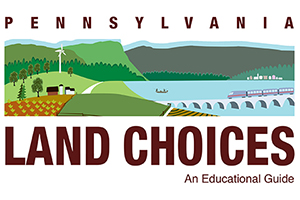Land Conservation and Stewardship Education
Conservation is not just part of DCNR’s name, it is deep-rooted in everything we do. We know that to make conservation truly successful every one of us needs to take action.
DCNR offers educational programming for all ages that helps all of us to become better stewards of the land across Pennsylvania.
Pennsylvania Land Choices Program

Pennsylvania Land Choices is an award-winning educational curriculum developed by the DCNR’s Bureau of State Parks as a tool for teachers to educate their students about land use, land conservation, and sustainable communities.
The lessons provide multi-modal, hands-on activities for students in grades 6-12.
From comparing aerial photographs to designing a park, Pennsylvania Land Choices provides inquiry-based activities aligned to current state academic standards.
The Pennsylvania Land Choices curriculum can only be obtained by attending a DCNR Bureau of State Parks educator workshop.
These courses provide the tools necessary for teachers to lead lessons on land use, community planning, and community investigations.
Find an upcoming educator workshop for Pennsylvania Land Choices on
DCNR's calendar of events.
Cavity-Nesting Trails Program
Learn how to become an involved citizen scientist through
DCNR’s Cavity-Nesting Trails Program (PDF).
A cavity-nesting trail is an area within a state park, which may or may not be along a trail, where man-made nesting boxes are placed for use by birds.
About the Cavity-Nesting Trails Program
As part of a national effort to provide nesting habitat for the then declining eastern bluebird population in the late 1980s, DCNR’s Bureau of State Parks developed a nest box monitoring program to coordinate the efforts and resources of interested parks and individuals.
The success of this endeavor led DCNR’s Bureau of State Parks to expand the program to include the monitoring of additional cavity-nesting birds, such as:
- Chickadees
- Wrens
- Tree swallows
- Purple martins
- Wood ducks
- Barn and eastern screech owls
- Kestrels
Program benefits include:
- Increase in cavity-nesting bird populations
- A wealth of accurate and reliable data for scientists to study
- The opportunity for thousands of park visitors to see and learn about the needs of cavity-nesting birds
Program Participation and Implementation
State parks’ involvement in the program varies. You may be able to start a new program in a state park or join one already underway.
To start a new program, you will need to meet with park personnel to develop an implementation plan.
This plan may include:
- Habitat appraisal and box location
- Review and coordination of responsibilities and reporting forms
- Training for individuals involved
- Development of a timeline for implementation
- Identification of other individuals or groups who may help
- Dissemination of background information on cavity nesting species